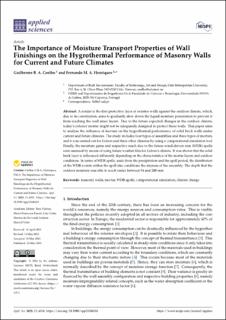| dc.contributor.author | Coelho, Guilherme Barreto Arez | |
| dc.contributor.author | Henriques, Fernando M.A. | |
| dc.date.accessioned | 2023-06-20T09:03:11Z | |
| dc.date.available | 2023-06-20T09:03:11Z | |
| dc.date.created | 2023-05-28T13:03:28Z | |
| dc.date.issued | 2023 | |
| dc.identifier.issn | 2076-3417 | |
| dc.identifier.uri | https://hdl.handle.net/11250/3072230 | |
| dc.description.abstract | A render is the first protective layer of exterior walls against the outdoor climate, which, due to its constitution, aims to gradually slow down the liquid moisture penetration to prevent it from reaching the wall inner layers. Due to the future expected changes in the outdoor climate, today’s exterior mortar might not be adequately designed to protect these walls. This paper aims to analyse the influence of mortars on the hygrothermal performance of solid brick walls under current and future climates. The study includes four types of assemblies and three types of mortars, and it was carried out for Lisbon and three other climates by using a computational simulation tool. Finally, the moisture gains and respective reach due to the future wind-driven rain (WDR) spells were assessed by means of using future weather files for Lisbon’s climate. It was shown that the solid brick layer is influenced differently depending on the characteristics of the mortar layers and outdoor conditions. In terms of WDR spells, aside from the precipitation and the spell period, the distribution of the WDR events within the spell also conditions the dryness of the assembly. The depth that the outdoor moisture was able to reach varies between 94 and 200 mm. | en_US |
| dc.language.iso | eng | en_US |
| dc.publisher | MDPI | en_US |
| dc.relation.ispartofseries | Applied Sciences; | |
| dc.rights | Navngivelse 4.0 Internasjonal | * |
| dc.rights.uri | http://creativecommons.org/licenses/by/4.0/deed.no | * |
| dc.title | The Importance of Moisture Transport Properties of Wall Finishings on the Hygrothermal Performance of Masonry Walls for Current and Future Climates | en_US |
| dc.type | Peer reviewed | en_US |
| dc.type | Journal article | en_US |
| dc.description.version | publishedVersion | en_US |
| cristin.ispublished | true | |
| cristin.fulltext | original | |
| cristin.qualitycode | 1 | |
| dc.identifier.doi | http://dx.doi.org/10.3390/app13106318 | |
| dc.identifier.cristin | 2149839 | |
| dc.source.journal | Applied Sciences | en_US |

